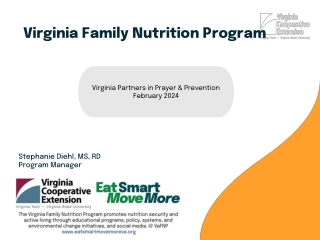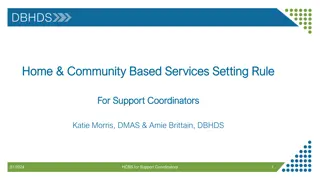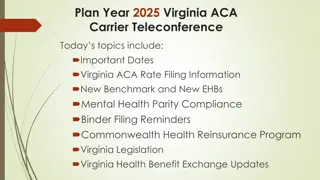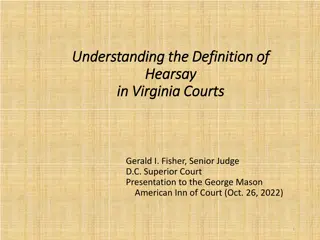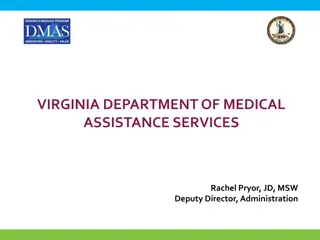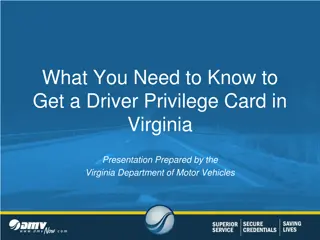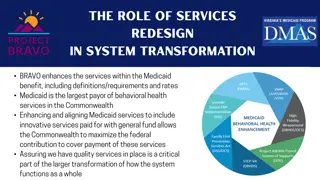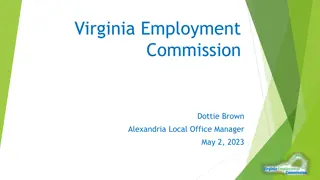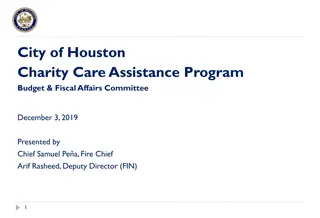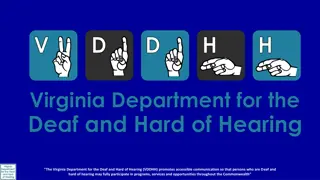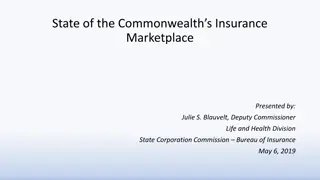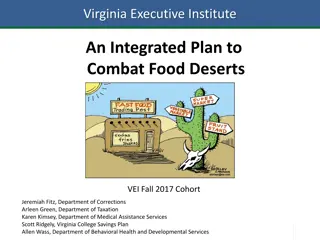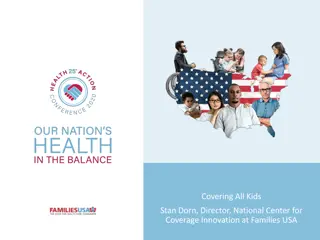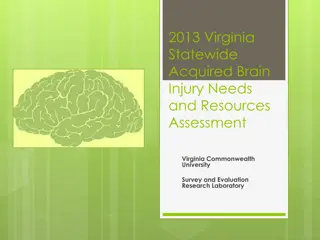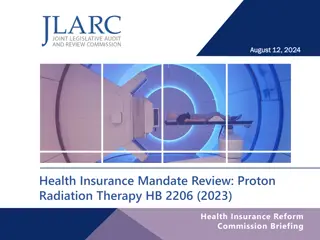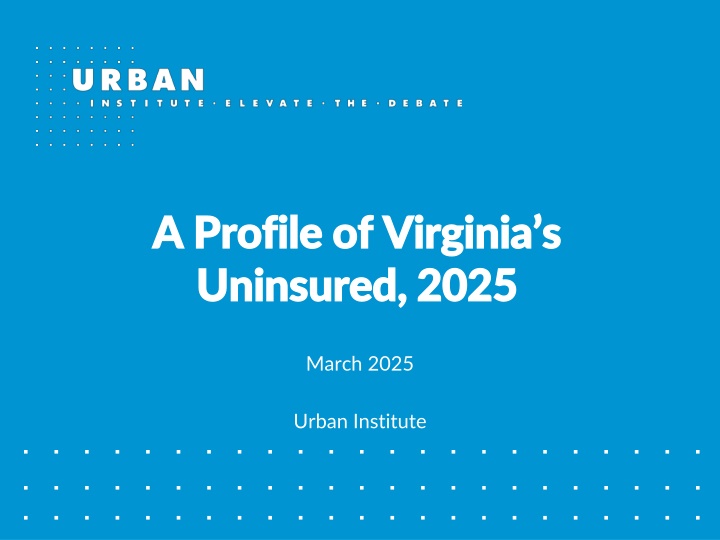
Insights into Virginia's Uninsured Population and Healthcare Policy Trends
Discover key findings from the 2025 profile of Virginia's uninsured, including insights from the American Community Survey and Behavioral Risk Factor Surveillance System. Learn about the impact of state and federal policy changes on reducing the number of uninsured Virginians, such as Medicaid expansion and Marketplace subsidies. Explore how the Medicaid unwinding may affect 2023 estimates and understand the implications for healthcare coverage in Virginia.
Download Presentation

Please find below an Image/Link to download the presentation.
The content on the website is provided AS IS for your information and personal use only. It may not be sold, licensed, or shared on other websites without obtaining consent from the author. If you encounter any issues during the download, it is possible that the publisher has removed the file from their server.
You are allowed to download the files provided on this website for personal or commercial use, subject to the condition that they are used lawfully. All files are the property of their respective owners.
The content on the website is provided AS IS for your information and personal use only. It may not be sold, licensed, or shared on other websites without obtaining consent from the author.
E N D
Presentation Transcript
A Profile of Virginias A Profile of Virginia s Uninsured, 2025 Uninsured, 2025 March 2025 Urban Institute
Methods and Limitations All data used in the 2025 Profile of Virginia s Uninsured are from the American Community Survey (ACS) and the Behavioral Risk Factor Surveillance System (BRFSS), which are conducted by the US Census Bureau and the Centers for Disease Control and Prevention, respectively. This report provides more in-depth information than the tables produced by the US Census Bureau. The family structures and corresponding income and employment estimates presented in the ACS analyses are based on tax units, or groups of individuals whose income would likely be counted together for the purposes of eligibility for Medicaid/Children s Health Insurance Programs (CHIP, also known as FAMIS) (Medicaid/FAMIS are known collectively in Virginia as Cardinal Care), or the Marketplace. Tax units are generally smaller than Census-reported families, and their income is generally lower than the Census estimates of family-based income. As a result, the ACS estimates of the number of uninsured by income may not match those from other sources that use other family and income units. 2 for the Virginia Health Care Foundation
Policy Background A number of state and federal policy changes since 2010 have reduced the number of uninsured Virginians: Allowing young adults to stay on their parents health insurance plan until age 26 beginning in 2010 under the Affordable Care Act. Introduction of subsidized coverage available through new Marketplaces beginning in 2014 under the Affordable Care Act. The state s expansion of Medicaid to include low-income nonelderly adults in 2019. The state s extension of post-partum Medicaid coverage to 12 months in 2022. The federal policy response to the COVID-19 pandemic, which included provisions to protect access to Medicaid/CHIP. As a result, very few people were disenrolled from Medicaid/CHIP from March 2020 through March 2023. Expanded Marketplace subsidies under the American Rescue Plan Act and Inflation Reduction Act (2021-2025). 3
The Medicaid Unwinding May Affect 2023 Estimates The federal continuous coverage provisions increased the potential misreporting of Medicaid/CHIP coverage. The ACS estimates in this analysis do not include additional Urban Institute adjustments for potential misreporting of Medicaid/CHIP coverage. Estimates of Virginia s uninsured developed using US Census data collected during the COVID-19 pandemic and the pandemic-related continuous coverage provision period (2021-2025) cannot be compared to estimates in earlier Profiles of Virginia s Uninsured. The unwinding of Medicaid continuous coverage provisions began on April 1, 2023 and it ended in May 2024 in Virginia when eligibility redeterminations for most Medicaid/CHIP members were completed. Because the ACS is administered on a rolling basis and states proceeded with unwinding at different rates, the 2023 ACS estimates do not fully reflect coverage before or after the unwinding. Uninsured rates in 2023 and 2024 may be higher than in prior years in some states due to the unwinding of the continuous coverage requirement. Virginia Medicaid/CHIP enrollment fell from 2.0 million in March 2023 to 1.8 million in October 2024, though Marketplace enrollment increased somewhat over this period. 4 for the Virginia Health Care Foundation
Main Takeaways for 2023 (1) There were about 530,000 nonelderly (ages 0-64) uninsured in Virginia in 2023, an uninsured rate of 7.6%. This represents a 6.7 percentage point reduction in the Virginia nonelderly uninsured rate since 2013, meaning 466,000 fewer Virginians uninsured 466,000 fewer Virginians uninsured relative to 2013. The reduction in uninsurance since 2013 coincides with the expansion of coverage under the Affordable Care Act through the Marketplaces and dependent coverage provisions, Virginia s 2019 expansion of Medicaid to include low-income nonelderly adults, Virginia s 2022 extension of postpartum Medicaid coverage to 12 months, the continuous coverage provisions during the COVID-19 pandemic (2020-2023), and expanded Marketplace subsidies under the American Rescue Plan Act and the Inflation Reduction Act (2021-2025). 5 for the Virginia Health Care Foundation
Main Takeaways for 2023 (2) Most (82.7%) nonelderly uninsured Virginians were adults (ages 19-64), and 83.9% were in families with at least one working adult. They represent a mix of races and ethnicities. In 2023, 51.3% of uninsured nonelderly Virginians lived in families with income up to 205% of the Federal Poverty Level (FPL), about the same as in 2022 (51.0%). Nonelderly uninsured rates were above 9 percent in three regions of the state: Newport News and Hampton (10.6%), the upper Shenandoah Valley area (9.5%), and Roanoke County and the Western Mountain area (9.1%). Uninsured adult Virginians were much more likely than insured Virginia adults to have unmet health needs due to cost and less likely to receive routine care. Among uninsured children (ages 0-18) in Virginia, 49.7% lived in families with income at or below 205% FPL in 2023. 6 for the Virginia Health Care Foundation
530,000 Virginians lacked health insurance coverage in 2023, 82.7% of whom were adults Total Nonelderly Virginians Nonelderly Uninsured Virginians Uninsured, 7.6% Children, 17.3% Adults, 82.7% Insured, 92.4% Source: Urban Institute, March 2025. Based on the 2023 American Community Survey (ACS) data from the Integrated Public Use Microdata Series (IPUMS). 7 for the Virginia Health Care Foundation
Nonelderly adults (19-64) were almost twice as likely to be uninsured as children in Virginia in 2023 15% Uninsurance Rate 10% 8.7% 7.6% 4.6% 5% 0% Children Adults All Nonelderly Source: Urban Institute, March 2025. Based on the 2023 American Community Survey (ACS) data from the Integrated Public Use Microdata Series (IPUMS). 8 for the Virginia Health Care Foundation
Almost half of uninsured children (49.7%) and 37.1% of uninsured adults in Virginia have family incomes that would make them potentially eligible for Medicaid/CHIP Adults, 19-64 Children, 0-18 49.7% Potentially Eligible for Medicaid/ CHIP ( 205%FPL) 47.6% Potentially Eligible for Marketplace Financial Assistance (139-400% FPL) 37.1% Potentially Eligible for Medicaid\CHIP ( 138% FPL) 30.0% Potentially Eligible for Marketplace Financial Assistance (206-400% FPL) 15.3% 401+% FPL 20.3% 401+% FPL Source: Urban Institute, March 2025. Based on the 2023 American Community Survey (ACS) data from the Integrated Public Use Microdata Series (IPUMS). Note: Those with incomes above 400% FPL may be eligible for Marketplace financial assistance under the American Rescue Plan Act/Inflation Reduction Act, which is set to expire at the end of 2025. Marketplace eligibility is also conditional on offers of coverage from employers. 9
The rate of uninsurance for nonelderly adult Virginians decreased significantly for every age group between 2013 and 2023 25.0% 23.2% 21.5% 20.0% 16.6% 15.0% 12.1% 11.5% 10.2% 10.0% 8.6% 5.3% 5.0% 0.0% 19-24 years 25-34 years 35-54 years 55-64 years 2013 2023 Source: Urban Institute, March 2025. Based on the 2023 American Community Survey (ACS) data from the Integrated Public Use Microdata Series (IPUMS). All differences between 2013 and 2023 are significant at the .10 level. 10
Virginias uninsured rate remained below the US overall from 2013 through 2023, but the gap narrowed 20% Virginia United States 16.9% 14.3% 15% 10.8% 10.2% 9.5% 9.4% 9.4% 10% 8.0% 7.7% 7.6% 5% 0% 2013 2019 2021 2022 2023 Source: Urban Institute, March 2025. Based on the 2013, 2019, 2021, 2022, and 2023 American Community Survey (ACS) data from the Integrated Public Use Microdata Series (IPUMS). Note: Implementation of primary elements of the Affordable Care Act began in 2014, to include the Health Insurance Marketplace and Marketplace-related financial assistance. Virginia s Medicaid eligibility requirements expanded to include nonelderly adults 138% FPL in 2019. 11 for the Virginia Health Care Foundation
Uninsurance in Virginia decreased among nonelderly adults and children between 2013 and 2023 2013 2019 2022 2023 25% 22.0% 20% 17.8% 14.3% 15% 11.0% 11.2% 11.1% 11.0% 9.4% 10% 9.0% 8.7% 7.7% 7.6% 5.5% 4.9% 4.6% 4.5% 5% 0% Total Nonelderly Children (0-18) Young Adults (19-25) All Adults (19-64) Source: Urban Institute, March 2025. Based on the 2013, 2019, 2022, and 2023 American Community Survey (ACS) data from the Integrated Public Use Microdata Series (IPUMS). Note: Implementation of primary elements of the Affordable Care Act began in 2014, to include the Health Insurance Marketplace and Marketplace-related financial assistance. Virginia s Medicaid eligibility requirements expanded to include adults 138% FPL in 2019. 12 for the Virginia Health Care Foundation
Over one-in-three nonelderly uninsured Virginians (0-64) had family income 138% FPL in 2023 15.3% 16.1% 20.3% 11.7% 11.2% 9.2% 401+% FPL 301-400% FPL 251-300% FPL 201-250% FPL 139-200% FPL 101-138% FPL 100% FPL 8.8% 8.9% 8.6% 12.3% 12.4% 12.2% 14.8% 15.1% 18.0% 9.7% 9.9% 10.8% 27.4% 26.3% 21.0% Total Nonelderly (0-64) Children (0-18)* Adults (19-64) Source: Urban Institute, March 2025. Based on the 2023 American Community Survey (ACS) data from the Integrated Public Use Microdata Series (IPUMS). Note: Family poverty level estimates are based on tax unit Modified Adjusted Gross Income and use the 2023 FPLs defined by the US Department of Health and Human Services. * Income breaks are slightly different for children, as follows: 139-200% is instead 139-205%, 201-250% is instead 206-256%, and 251-300% is instead 256-300%. 13 for the Virginia Health Care Foundation
Adult Virginians (19-64) with incomes 138% FPL were more than 5 times as likely to be uninsured as those with incomes 401+% FPL in 2023 Children with family incomes 138%FPL were more than twice as likely to be uninsured as those in families with incomes 401%+ FPL. Adults Children 15.3% 12.9% 6.0% 6.0% 2.9% 2.4% 139-400% FPL 401+% FPL 138% FPL Source: Urban Institute, March 2025. Based on the 2023 American Community Survey (ACS) data from the Integrated Public Use Microdata Series (IPUMS). Notes: Family poverty level estimates are based on tax unit Modified Adjusted Gross Income and use the 2023 FPLs defined by the US Department of Health and Human Services. 14 for the Virginia Health Care Foundation
Most uninsured Virginians (73.6%) lived in families with at least one full-time worker in 2023 Share of Nonelderly Uninsured One full-time worker, 55.8% Child not living with parents, 1.1% Two full-time workers, 17.8% No working adults, 15.0% Part-time worker(s) only, 10.4% Source: Urban Institute, March 2025. Based on the 2023 American Community Survey (ACS) data from the Integrated Public Use Microdata Series (IPUMS). Notes: Family work status is based on the work status of adults in the tax unit. Estimates may not sum to 100% due to rounding. 15 for the Virginia Health Care Foundation
Uninsured nonelderly Virginians were diverse with respect to race and ethnicity in 2023 Share of Nonelderly Uninsured Hispanic, 33.5% White, 37.4% Other/Multiple, 6.1% Black or African American, 17.7% Asian/Pacific Islander, 5.3% Source: Urban Institute, March 2025. Based on the 2023 American Community Survey (ACS) data from the Integrated Public Use Microdata Series (IPUMS). Notes: Estimates may not sum to 100% due to rounding. 16 for the Virginia Health Care Foundation
Uninsured nonelderly adults in Virginia reported less access to care than insured nonelderly adults in 2023 Insured nonelderly adults Uninsured nonelderly adults 86.9% 80.0% 72.3% 47.2% 45.0% 42.8% 38.7% 35.4% 33.6% 27.3% 17.2% 7.7% Regular provider Routine checkup Flu shot Had a dental visit Unmet needs due Lost any permanent teeth to cost Source: Urban Institute, March 2025. Based on the 2023 Behavioral Risk Factor Surveillance System. 17
A Profile of Virginias A Profile of Virginia s Uninsured, 2025: Maps Uninsured, 2025: Maps
Table of Contents Guide to Regions of Virginia Map 1: Uninsured rate for all nonelderly (0-64) Virginians in 2023, by region Map 2: Uninsured rate for all children (0-18) in Virginia in 2023, by region Map 3: Uninsured rate for all nonelderly adults (19-64) Virginians in 2023, by region Map 4: Uninsured rate for all nonelderly adults (19-64) in Virginia with family income 138% FPL in 2023, by region Map 5: Share of uninsured nonelderly adults (19-64) in Virginia with family income 138% FPL in 2023, by region Map 6: Uninsured rate for all children (0-18) in Virginia with family income 205% FPL in 2023, by region Map 7: Share of uninsured children (0-18) in Virginia with family income 205% FPL in 2023, by region Notes: Uninsured rate refers to the percentage of Virginians in the specified group who are uninsured. Share of uninsured refers to the percentage of the uninsured who are in the specified group. Maps showing rates use a blue color scheme. Maps showing share use a green color scheme. In 2022, the Census Bureau changed the Public Use Microdata Areas based on the 2020 Census. Regional estimates for 2023 are not comparable to estimates prior to 2022 as a result. 19 for the Virginia Health Care Foundation
Guide to Regions of Virginia Region 1 Alexandria City Arlington Region 5 Accomack Caroline Essex Gloucester James King and Queen King George Lancaster Mathews Middlesex Region 8 Charles Chesterfield Goochland Hanover Henrico King William New Kent Powhatan Richmond City Region 10 Amelia Amherst Appomattox Bedford Bedford City Brunswick Buckingham Campbell Charlotte Colonial Heights Region 11 Bland Bristol Buchanan Carroll Dickenson Floyd Galax Giles Grayson Lee Region 12 Chesapeake Franklin Isle of Wight Norfolk City Portsmouth Southampton Suffolk Virginia Beach Patrick Petersburg Pittsylvania Prince Edward Prince George Surrey Sussex Region 2 Fairfax Fairfax City Falls Church Region 3 Fredericksburg Manassas Manassas Park City Prince William Stafford Region 9 Alleghany Augusta Bath Botetourt Buena Vista Covington Craig Franklin Highland Lexington Roanoke Roanoke City Rockbridge Salem Staunton Waynesboro Region 13 Hampton Newport News Montgomery Norton Pulaski Radford Russell Scott Smyth Tazewell Washington Wise Wythe Northampton Northumberland Poquoson Richmond Spotsylvania Westmoreland Williamsburg York Cumberland Danville Dinwiddie Emporia Greensville Halifax Henry Hopewell Lunenburg Lynchburg Martinsville Mecklenburg Nottoway Region 4 Clarke Frederick Harrisonburg Page Rockingham Shenandoah Warren Winchester Region 6 Loudoun 6 2 1 Region 7 Albemarle Charlottesville Culpeper Fauquier Fluvanna Greene Louisa Madison Nelson Orange Rappahannock 4 3 7 5 9 8 10 13 11 12 Note: Localities are grouped to ensure sufficient sample sizes at the regional level. 20 for the Virginia Health Care Foundation
Map 1: Uninsured rate for all nonelderly (0-64) in each region of Virginia in 2023 6 5.0% Uninsurance rate among all nonelderly (VA Rate: 7.6%) 2 6.8% 1 6.3% 3 8.9% 4 9.5% 7 5 7.9% 9 6.5% 9.1% 8 7.5% 13 10.6% 11 6.8% 10 7.3% 12 7.7% Source: Urban Institute, March 2025. Based on the 2023 American Community Survey (ACS) data from the Integrated Public Use Microdata Series (IPUMS). For area definitions, see Guide to Regions of Virginia . 21 for the Virginia Health Care Foundation
Map 2: Uninsured rate for all children (0-18) in each region of Virginia in 2023 6 2.6% 2 Uninsurance rate among all children (VA Rate: 4.6%) 3.9% 1 1.6% 3 5.0% 4 7.1% 7 5 4.9% 9 2.4% 7.8% 8 5.6% 13 7.3% 11 3.0% 10 4.0% 12 4.8% Source: Urban Institute, March 2025. Based on the 2023 American Community Survey (ACS) data from the Integrated Public Use Microdata Series (IPUMS). For area definitions, see Guide to Regions of Virginia . 22 for the Virginia Health Care Foundation
Map 3: Uninsured rate for all nonelderly adults (19-64) in each region of Virginia in 2023 6 Uninsurance rate among all nonelderly adults (VA Rate: 8.7%) 6.2% 2 8.0% 1 7.6% 3 10.7% 4 10.4% 7 5 9.1% 9 8.2% 9.6% 8 8.1% 13 12.1% 11 8.1% 10 8.5% 12 9.0% Source: Urban Institute, March 2025. Based on the 2023 American Community Survey (ACS) data from the Integrated Public Use Microdata Series (IPUMS). For area definitions, see Guide to Regions of Virginia . 23 for the Virginia Health Care Foundation
Map 4: Uninsured rate for nonelderly adults (19-64) in each region of Virginia with family income 138% FPL in 2023 6 Uninsurance rate among adults 138% FPL (VA Rate: 15.3%) 15.7% 2 21.9% 1 18.7% 3 20.4% 4 13.2% 7 5 16.2% 16.2% 9 15.5% 8 15.2% 13 19.0% 11 10.4% 10 10.8% 12 14.0% Source: Urban Institute, March 2025. Based on the 2023 American Community Survey (ACS) data from the Integrated Public Use Microdata Series (IPUMS). For area definitions, see Guide to Regions of Virginia . 24 for the Virginia Health Care Foundation
Map 5: Share of uninsured nonelderly adults (19-64) in each region of Virginia with family income 138% FPL in 2023 6 28.3% 2 Share of uninsured adults 138% FPL (VA Share: 37.1%) 43.6% 1 25.6% 3 30.7% 4 29.7% 7 5 39.3% 41.4% 9 38.5% 8 36.4% 13 42.4% 11 43.9% 10 40.3% 12 35.9% Note: In 2022, the Census Bureau changed the Public Use Microdata Areas based on the 2020 Census. Regional estimates for 2022 are therefore not comparable to prior years. Source: Urban Institute, March 2025. Based on the 2023 American Community Survey (ACS) data from the Integrated Public Use Microdata Series (IPUMS). For area definitions, see Guide to Regions of Virginia . 25 for the Virginia Health Care Foundation
Map 6: Uninsured rate for children (0-18) in each region of Virginia with family income 205% FPL in 2023 6 Uninsurance rate among children 205% FPL (VA Rate 6.4%) 5.5% 2 5.5% 1 1.1% 3 7.5% 4 5.1% 7 5 4.4% 2.0% 9 9.3% 8 6.3% 13 7.4% 11 3.3% 10 2.4% 12 5.0% Source: Urban Institute, March 2025. Based on the 2023 American Community Survey (ACS) data from the Integrated Public Use Microdata Series (IPUMS). For area definitions, see Guide to Regions of Virginia . 26 for the Virginia Health Care Foundation
Map 7: Share of uninsured children (0-18) in each region of Virginia with family income 205% FPL in 2023 Note: Regions in gray have a sample size below 50 and have been suppressed. 6 Share of uninsured children 205% FPL (VA Rate 49.7%) 2 28.6% 1 4 3 28.7% 40.8% 7 5 9 52.3% 8 35.5% 13 11 10 33.7% 12 43.4% Source: Urban Institute, March 2025. Based on the 2023 American Community Survey (ACS) data from the Integrated Public Use Microdata Series (IPUMS). For area definitions, see Guide to Regions of Virginia . 27 for the Virginia Health Care Foundation

